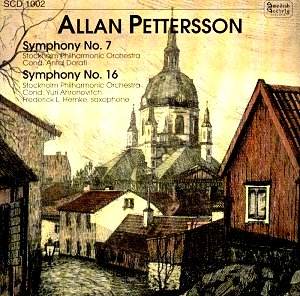As the messages to this site’s Bulletin
Board demonstrate Pettersson continues to provoke strong feelings.
However one chooses to describe him, adjectivally speaking – and
we all know the kind of things that are said of him – listening
to a Pettersson Symphony at his greatest is one of the most charged,
moving and shaking experiences in late twentieth century music.
And of all the works of his that I know it is the Seventh – in
this by now classic performance – that shakes me the most.
Over the course of its forty-minute span we follow
a symphonic argument of development and rare drama and one that
reveals itself to be profoundly human in its breadth. Listening
to it again for review purposes and writing down scraps of notes
one can see perhaps more clearly that however anguished the language
the structure is firm. From the static opening with those sepulchral
brass to the sense of redirection of energy that is soon generated
we are in the grip of a symphonist of stature. The insistence
of the horn layers from 6’00 and the obsessively frantic drum
tattoos and searing violins open out into a kind of March-Chorale
before the inevitable symphonic catastrophe hits. The lyrical
outburst in response to this assault (just hear how the violins
try to play through the cataclysm) leads to the strings playing
higher and higher as if the very fiddles themselves are striving
for oxygen. It is the consolation of the winds that ushers in
the beautiful, aching string cantilena from 25’00 or thereabouts,
moments of the most extraordinary hope and refuge, real and human
and of terrible beauty. Inevitably the line cannot withstand the
renewed attacks but this time, in time, the fragments of orchestral
sound and colour – flute solos, striding bass pizzicati, wandering
strings – lead to a long-breathed sense of almost-resolution.
Once again the strings soar high up, the lower strings repeat
themselves and a brass figure ends it all. In print it seems schematic;
in practice it is astonishing, a threnody of compelling beauty
and harrowing fissures.
Its companion, the Sixteenth, was his last completed
Symphony and commissioned by the saxophonist here, Frederick L
Hemke. Opening with a jagged and short series of motifs and stern
drum tattoos the rather - and appropriately – sour-sounding saxophone’s
independence of line seems an act of heroism given the mayhem
of motion that buffets and surrounds it. Around 7.00 the orchestral
tumult subsides and we can hear the high winds, which shepherd
the solo instrumentalist through the next stages until a magical
withdrawal of tone at 9.20 – beautiful and ruminative. From 11.50
there is a dramatic accelerando for the saxophone, with a hint
of menace, followed by an uneasy-sounding cantilena. In its concision
and abrupt disjunctions this is a work that fights and refuses
to yield or to go gentle into that good night.
The notes reprint those for the relevant LP issues
of these two symphonies. If you try anything of Pettersson’s let
it be this Seventh.
Jonathan Woolf
